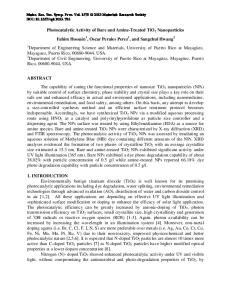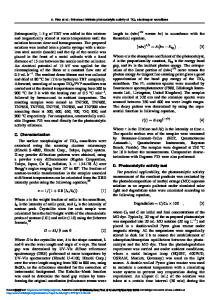Magnetic photocatalysts containing TiO 2 nanocrystals: Morphology effect on photocatalytic activity
- PDF / 637,703 Bytes
- 9 Pages / 584.957 x 782.986 pts Page_size
- 56 Downloads / 858 Views
Fe3O4@TiO2 magnetic photocatalysts containing sub-10-nm TiO2 nanocrystals with two different morphologies (nanoparticles and nanorods) were prepared via a facile straight dipping process. A series of comparative experiments on organic pollutant degradation demonstrated that Fe3O4@TiO2 nanorods show superior activity and faster degradation rates than Fe3O4@TiO2 nanoparticles. Combined with the study of high resolution transmission electron microscopy, crystal models are given to analyze the morphology effect of TiO2 nanocrystals on their photocatalytic activities for organic degradation. TiO2 nanorods with more (100) crystal planes, which have relatively higher surface energy and relative higher density of Ti atoms, showed a higher activity than that of TiO2 nanoparticles. Furthermore, both Fe3O4@TiO2 nanorods and Fe3O4@TiO2 nanoparticles show better photocatalytic activities than several comparison Fe3O4@TiO2 samples due to the strong size effect arising from the tiny size of TiO2 nanorods and nanoparticles. These magnetic photocatalysts also show advantages in separation and recycling utilization. I. INTRODUCTION
In the past decades, many efforts have been focused on the synthesis and property studies of TiO2 photocatalysts for designing, selecting, and developing highly reactive photocatalysts due to its wide band gap, strong oxidizing power, long-term stability against photo and chemical corrosion, low cost, and low toxicity.1–6 It has been well documented that besides chemical compositions, the structural and morphology properties, such as the size, shape, and crystal planes, also greatly influence the performance of photocatalysts. TiO2 nanocrystals, especially those with sizes within sub-10 nm, exhibit superior photocatalytic activity to the corresponding bulk material, due to their unique shape/size depended properties, surface effect, and quantum confinement effect.7,8 However, there are still some technical difficulties in the practical applications of these TiO2 nanocrystals as photocatalysts in the field of water treatments. First, many successful synthetic method of TiO2 nanocrystals adopts the nonaqueous system or use some organic capping agents, such as oleylamine,9 CTAB, and hexamethylenetetramine.10 As a result, the synthesized TiO2 nanocrystals have a hydrophobic surface, which prevents the dispersion of the TiO2 nanocrystals in polar solvent and limits their application in water. Second, it is difficult to separate and recycle the photocatalysts after photocatalytic treatment due to the tiny size of TiO2 nanocrystals, which cost a)
Address all correspondence to this author. e-mail: [email protected] DOI: 10.1557/jmr.2013.233 98
J. Mater. Res., Vol. 29, No. 1, Jan 14, 2014
http://journals.cambridge.org
Downloaded: 03 Dec 2014
additional energy to separate these particles from wastewater. Aiming at addressing these problems, magnetic photocatalysts, the photoactive TiO2 nanoparticles coated on the surface of the magnetic core, have been used, which have attracted considerable interests for
Data Loading...











